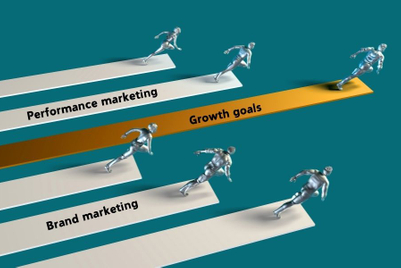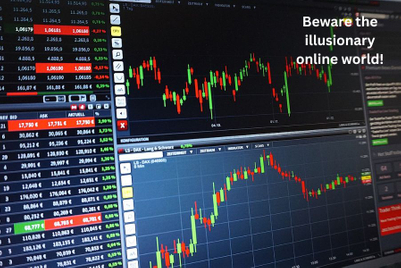
Imagine spending your entire marketing budget chasing just 5% of your potential customers. Many direct-to-consumer (DTC) brands face this reality today, locked in a costly battle for buyers who are already interested—while ignoring the 95% who could shape their future.
The laser focus of performance marketing on return on ad spend (ROAS) and cost per acquisition (CPA) metrics creates a false impression: quick wins may blur the slow erosion of brand value and customer loyalty. As rivals rush to the same small group of ‘ready-to-buy’ shoppers, getting new customers becomes pricier, profits get squeezed, and growth hits a wall.
At the same time, the bigger chance—the 95% still looking around unaware of what you offer or not yet sold—goes untouched. Brands that care about quick sales risk becoming irrelevant to the people they’ll need most down the road.
Performance marketing captures consumer attention because it gives clear, easy-to-measure outcomes. Companies can link their costs straight to sales and tweak things on the fly based on how their campaigns are doing.
But when businesses focus too much on quick results, they might miss the forest for the trees. Looking only at instant sales can lead to several issues. A narrow audience focus is one such issue.
Emphasising only performance metrics often leads to targeting just those consumers who are ready to buy now. Studies indicate that only about 5% of the market is prepared to purchase at any given time. By neglecting the other 95%, brands ignore a large group of potential future customers.
As every brand in the DTC sector chases the same small group of ready-to-buy customers, it results in bidding wars, driving up advertising costs, and making it more expensive to get new customers.
The higher the cost to acquire customers the lower the overall profit. Performance marketing might bring quick wins, but these might not lead to lasting growth. Without putting money into brand awareness, companies might see a quick jump in sales to face smaller returns as they use up their potential customer base.
The 5% versus 95% dilemma
Knowing how ready customers are to buy is key. Performance marketing zeroes in on the 5% of people who want to buy right now. The other 95% are folks at different points in their path to purchase. Although these consumers may not be ready to convert immediately, they play a vital role in the long-term growth of a brand.
This distinction is important. Although 95% of potential customers may not convert immediately, they can be cultivated over time with effective brand exposure. Building a partnership and staying top of mind helps companies to transform these leads when they are ready, thus guaranteeing a steady stream of revenue.
Lowering acquisition costs over time is another advantage. Investing in brand knowledge helps produce a more open audience, which in itself can help to reduce customer acquisition costs by lowering them over time. Performance marketing campaigns usually work better and faster when customers already know and believe in your goods.
Lastly, it helps to create a sustainable customer base. Aim for a wider audience. Recognition, trust, and a deep emotional link with the brand underlie this loyalty—components that are sometimes absent in a performance-based approach.
Balancing brand awareness with performance marketing
Finding a balance is the key to addressing the difficulties involved in a performance-only strategy. Businesses need to include brand awareness in their marketing plan.
However, achieving this with limited resources can be difficult. These techniques will assist in finding that middle ground.
Consider performance and brand marketing as complementary components of a single plan of action rather than as distinct activities. While performance marketing drives immediate sales, brand marketing lays the groundwork for long-term success.
Draw your audience in with relevant information that transcends product features. To make an emotional bond with your brand and humanise it, storytelling is used. This is particularly valuable for smaller companies wanting to distinguish themselves in a saturated sector.
Implementing multichannel campaigns will help engage and educate the general public over several touchpoints. Through a mixture of performance strategies and brand building initiatives, you produce a funnel that supports consumers at every step of their travel.
Track brand sentiment and awareness over time with data analytics, not just short-term indicators. With this two-fold approach, you can change your plan to guarantee both present and long-term advantages.
Scaling your brand
It is important to clarify that performance marketing is not without merit. It plays a crucial role in scaling a brand by driving conversions and providing the immediate revenue necessary for reinvestment.
There are reasons why performance marketing remains a key component; it provides tangible evidence of a campaign's efficacy. This openness guarantees that every dollar used is justified and helps in fast modifications.
For emerging brands with limited funds, performance marketing can be a cost-effective way to generate immediate returns. It provides the cash flow needed to invest further in brand-building initiatives.
Performance ads are ideal vehicles for testing fresh ideas and messaging. The live data lets you see what your audience finds appealing, which observations can later be used in larger general brand plans.
Lastly, when integrated effectively, performance marketing can amplify brand awareness. Ongoing brand messaging could help to foster the first spark of a performance campaign, therefore, creating a loop of participation that improves both short and long-range goals.
Budget allocations for emerging brands
Limited marketing budgets can be a problem for small businesses. The key is to apportion funds in a way that supports both immediate conversions and long-term growth.
The way to do this is start small and scale gradually by making modest investments in brand awareness. Test various channels—content marketing, social media, influencer partnerships—to determine what motivates contact with the broad audience.
Instead of focusing purely on conversions, also look at other aspects such as brand lift studies, customer sentiment, and engagement rates. A more general view helps support the money spent on brand marketing.
Take an iterative approach by consistently evaluating the performance of your campaigns based on how well your content is worded. Also, check if increasing expenditures causes performance marketing initiatives to produce fewer returns; allocate more money to developing your brand identity and customer connections.
Finally, create integrated campaigns that flow naturally from brand messaging to performance objectives. A social media initiative, for instance, could boost current sales while also telling the story of the business—thus developing future customers.
Building trust for long-term survival
Beyond a marketing strategy, establishing brand trust is another vital strategic need for long-term survival. Consumers have many choices in the digital age of today, so trust distinguishes among others.
Trust translates into customer loyalty, which is invaluable in a competitive marketplace. Loyal customers not only provide repeat business but also act as advocates for your brand.
A reputable brand will better handle market volatility and financial volatility. Trusting your company helps clients to stick with you even through difficult times. The customers who are not ready to buy today will become tomorrow’s loyal patrons if nurtured correctly. Establishing trust guarantees that you are well-placed to meet this future need.
For DTC brands looking for fast expansion and quick profits, it is tempting to depend solely on performance marketing. However, fundamentally, this method is restricted as it causes intense competition and high acquisition costs. Eventually, this could result in a disregard of the larger audience that is key to sustained growth since only around 5% of consumers are ready to buy at any given time.
Performance marketing can help your brand scale as it delivers quantifiable and quick results that may could drive revenue and confirm strategic decisions, but it has to be approached prudently. Companies without simultaneous brand awareness run the risk of using their budgets for quick results only to damage themselves and neglect to develop the majority of potential customers.
For emerging brands, the challenge lies in balancing these two vital aspects of marketing. Businesses can develop a sustainable growth engine by combining strong brand-building initiatives with performance strategies that drive present sales and lay the groundwork for future success. By building brand trust today, you guarantee your brand can resist the competitive pressures of tomorrow, thereby creating a loyal customer base that will maintain your company for many years.
The key takeaway is simple: in the digital age, success is not accomplished by following only immediate conversions but by developing a more extensive, more active audience. Companies can scale their operations effectively and create the lasting trust needed for long-term success by strategically balancing brand awareness and performance marketing.

— Prady Kumaar, CEO and co-founder, NP Digital India.


.jpg&h=334&w=500&q=100&v=20250320&c=1)
.jpg&h=334&w=500&q=100&v=20250320&c=1)



.jpg&h=334&w=500&q=100&v=20250320&c=1)
.jpg&h=334&w=500&q=100&v=20250320&c=1)


.jpg&h=334&w=500&q=100&v=20250320&c=1)




.jpg&h=268&w=401&q=100&v=20250320&c=1)

.jpg&h=268&w=401&q=100&v=20250320&c=1)

